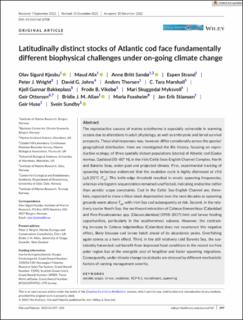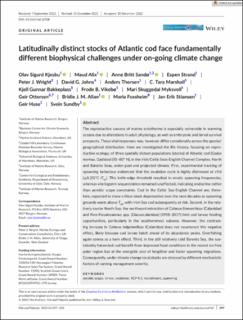Latitudinally distinct stocks of Atlantic cod face fundamentally different biophysical challenges under on-going climate change
| dc.contributor.author | Kjesbu, Olav Sigurd | |
| dc.contributor.author | Alix, Maud | |
| dc.contributor.author | Sandø, Anne Britt | |
| dc.contributor.author | Strand, Espen | |
| dc.contributor.author | Wright, Peter J. | |
| dc.contributor.author | Johns, David G. | |
| dc.contributor.author | Thorsen, Anders | |
| dc.contributor.author | Marshall, C. Tara | |
| dc.contributor.author | Bakkeplass, Kjell Gunnar | |
| dc.contributor.author | Vikebø, Frode Bendiksen | |
| dc.contributor.author | Myksvoll, Mari Skuggedal | |
| dc.contributor.author | Ottersen, Geir | |
| dc.contributor.author | Allan, Bridie Jean Marie | |
| dc.contributor.author | Fossheim, Maria | |
| dc.contributor.author | Stiansen, Jan Erik | |
| dc.contributor.author | Huse, Geir | |
| dc.contributor.author | Sundby, Svein | |
| dc.date.accessioned | 2024-01-04T09:48:54Z | |
| dc.date.available | 2024-01-04T09:48:54Z | |
| dc.date.created | 2023-02-19T12:24:53Z | |
| dc.date.issued | 2023 | |
| dc.identifier.citation | Fish and Fisheries. 2023, 1-24. | en_US |
| dc.identifier.issn | 1467-2960 | |
| dc.identifier.uri | https://hdl.handle.net/11250/3109773 | |
| dc.description.abstract | The reproductive success of marine ectotherms is especially vulnerable in warming oceans due to alterations in adult physiology, as well as embryonic and larval survival prospects. These vital responses may, however, differ considerably across the species' geographical distribution. Here we investigated the life history, focusing on reproductive ecology, of three spatially distant populations (stocks) of Atlantic cod (Gadus morhua, Gadidae) (50–80° N), in the Irish/Celtic Seas-English Channel Complex, North and Barents Seas, under past and projected climate. First, experimental tracking of spawning behaviour evidenced that the ovulation cycle is highly distressed at ≥9.6 (±0.25)°C (Tup). This knife-edge threshold resulted in erratic spawning frequencies, whereas vitellogenin sequestration remained unaffected, indicating endocrine rather than aerobic scope constraints. Cod in the Celtic Sea-English Channel are, therefore, expected to show critical stock depensation over the next decades as spawning grounds warm above Tup, with Irish Sea cod subsequently at risk. Second, in the relatively cooler North Sea, the northward retraction of Calanus finmarchicus (Calanidae) and Para-Pseudocalanus spp. (Clausocalanidae) (1958–2017) limit cod larvae feeding opportunities, particularly in the southernmost subarea. However, the contrasting increase in Calanus helgolandicus (Calanidae) does not counteract this negative effect, likely because cod larvae hatch ahead of its abundance peaks. Overfishing again comes as a twin effect. Third, in the still relatively cold Barents Sea, the sustainably harvested cod benefit from improved food conditions in the recent ice-free polar region but at the energetic cost of lengthier and faster spawning migrations. Consequently, under climate change local stocks are stressed by different mechanistic factors of varying management severity. | en_US |
| dc.language.iso | eng | en_US |
| dc.title | Latitudinally distinct stocks of Atlantic cod face fundamentally different biophysical challenges under on-going climate change | en_US |
| dc.title.alternative | Latitudinally distinct stocks of Atlantic cod face fundamentally different biophysical challenges under on-going climate change | en_US |
| dc.type | Peer reviewed | en_US |
| dc.type | Journal article | en_US |
| dc.description.version | publishedVersion | en_US |
| dc.source.pagenumber | 1-24 | en_US |
| dc.source.journal | Fish and Fisheries | en_US |
| dc.identifier.doi | 10.1111/faf.12728 | |
| dc.identifier.cristin | 2127280 | |
| dc.relation.project | Norges forskningsråd: 325665 | en_US |
| dc.relation.project | Trond Mohn stiftelse: BFS2018TMT01 | en_US |
| dc.relation.project | Norges forskningsråd: 133836 | en_US |
| cristin.ispublished | true | |
| cristin.fulltext | original | |
| cristin.fulltext | original | |
| cristin.qualitycode | 2 |
Tilhørende fil(er)
Denne innførselen finnes i følgende samling(er)
-
Articles [3012]
-
Publikasjoner fra CRIStin [3070]

